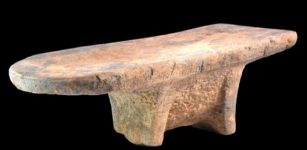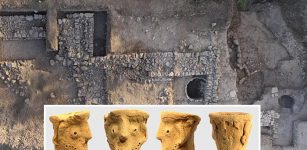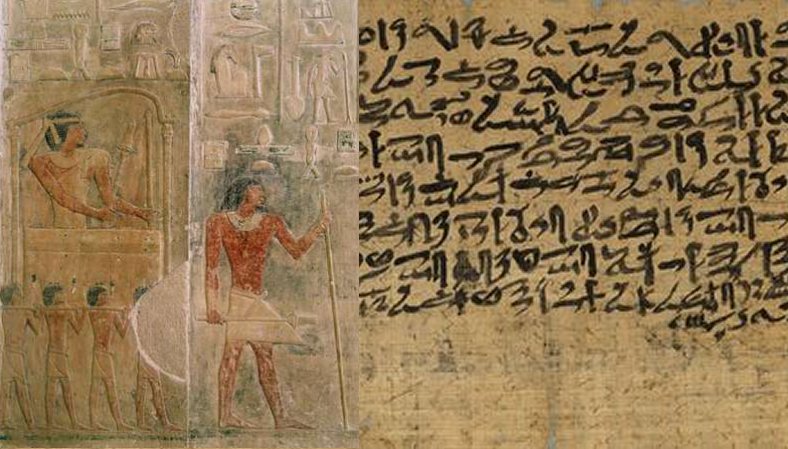Secrets Of Maxims Of Ptahhotep – Ancient Egyptian Wisdom Is Still Relevant Today
Ellen Lloyd - AncientPages.com - The history of ancient Egypt may sometimes seem very distant, but people living thousands of years ago had many problems and feelings that trouble us today.
During the Fifth Dynasty (2,500 B.C. – 2,350 B.C), Egyptian Vizier Ptahhotep, occasionally known as Ptahhotep I, Ptahhotpe or Ptah-Hotep wrote several instructions based on his wisdom and experiences.
His precious text contains advice on how to live your life, and much of what he wrote is still highly relevant today.
The Maxims of Ptahhotep influenced later philosophical works, and his work is one of the first Egyptian books.
Left: Ptahhotep on a palanquin, relief from his tomb. Werner-Forman Archive/Heritage-Images - Right: The Maxims of Ptahhotep, Public Domain
This precious ancient text was discovered in Thebes in 1847 by Egyptologist M. Prisse d’Avennes. There are four copies of the Instructions, and the only complete version, Papyrus Prisse, is located in the Bibliothèque Nationale in Paris.
Vizier Ptahhotep’s wisdom literature was basically a set of moral advice and proverbs for young men. Ptahhotep was a very intelligent man who was the city administrator and vizier (first minister) during the reign of Djedkare Isesi. He had a son named Akhethotep, who was also a vizier. He and his descendants were buried at Saqqara.
His grandson Ptahhotep Tshefi's writings were collected from his grandfather’s texts that were written using hieratic writing, that is, a simplification of the hieroglyphic writing used by the scribes to write on papyri.
In his writings, Ptahhotep reveals that he has dedicated his long life to obtaining wisdom, which can never be completely achieved.
Then the book is spelled out in a series of brief tips that are grouped into 37 topics. In his introduction, reminded us that knowledge is endless. "Do not be arrogant because of your knowledge, but confer with the ignorant man as with the learned. For knowledge has no limits, and none has yet achieved perfection in it."
Originally published as "The Instruction of Ptah-Hotep" and also as "The Maxims of Ptahhotep," the work is believed by some scholars to be the oldest book in the world. Authorship is attributed to Ptahhotep, a vizier under King Isesi of the Egyptian Fifth Dynasty (ca. 2414-2375 BC). It is a collection of maxims and advice in the sebayt ("teaching") genre on human relations and are provided as instruction for his son. The work survives today in papyrus copies, including the Prisse Papyrus which dates from the Middle Kingdom and is on display at the Bibliothèque Nationale in Paris. There are considerable differences between the Prisse Papyrus version and the two texts at the British Museum. The 1906 translation by Battiscombe Gunn, published as part of the "Wisdom of the East" series and which is reprinted here, was made directly from the Prisse Papyrus, in Paris, rather than from copies. Some lessons include: Learning by listening to everybody and knowing that human knowledge is never perfect are a leitmotif. Avoiding open conflict wherever possible should not be considered weakness. Justice should be pursued and in the end it will be a god's command that prevails. Greed is the base of all evil and should be guarded against, while generosity towards family and friends is praiseworthy. Read more
Ptahhotep also advises against listening to rumors and spreading slander. Maxim no. 21 states: "Do not repeat slander; you should not hear it, for it is the result of hot temper."
From Maxim no. 34, we learn that Ptahhotep was a man of peace rather than war. He advised: "Be a craftsman in speech that thou mayest be strong, for the strength of one is the tongue, and speech is mightier than all fighting."
There are naturally many more examples of guidance, and anyone interested in ancient Egyptian wisdom may find his thoughts interesting. His wisdom quotes are collected in The Teachings of Ptahhotep: The Oldest Book in the World.
Ptahhotep rests in the mastaba designated D64. His tomb is famous for its outstanding depictions.
The reliefs in the tomb chamber are the best preserved in the Old Kingdom.
Updated on October 13, 2024
Written by Ellen Lloyd – AncientPages.com
Copyright © AncientPages.com All rights reserved. This material may not be published, broadcast, rewritten or redistributed in whole or part without the express written permission of AncientPages.com
Expand for referencesMore From Ancient Pages
-
 Unique Treasure Of 500 Coins Accidentally Found Under Church Floor In Slovakia
Archaeology | Apr 6, 2020
Unique Treasure Of 500 Coins Accidentally Found Under Church Floor In Slovakia
Archaeology | Apr 6, 2020 -
 Knights Templar – Strict Rules For Clothing And Eating Habits
Featured Stories | Jan 2, 2018
Knights Templar – Strict Rules For Clothing And Eating Habits
Featured Stories | Jan 2, 2018 -
 Lost Astronomical Treatise By Claudius Ptolemy Discovered
Archaeology | Mar 30, 2023
Lost Astronomical Treatise By Claudius Ptolemy Discovered
Archaeology | Mar 30, 2023 -
 Ziggurats, Axis Mundi And Strong Connection To Religion In Mesopotamia
Featured Stories | Mar 17, 2021
Ziggurats, Axis Mundi And Strong Connection To Religion In Mesopotamia
Featured Stories | Mar 17, 2021 -
 Setne Khamwas And The Book Of Magic Written By Thoth
Featured Stories | Jan 20, 2016
Setne Khamwas And The Book Of Magic Written By Thoth
Featured Stories | Jan 20, 2016 -
 ‘Our Way Model’ Reveals How First Anatomically Modern Humans Populated Europe
Human Beginnings | Oct 7, 2024
‘Our Way Model’ Reveals How First Anatomically Modern Humans Populated Europe
Human Beginnings | Oct 7, 2024 -
 Qanats: Ancient 3,000-Year-Old Underground Irrigation Canals Invented By People Of Persia
Ancient Technology | Jul 13, 2020
Qanats: Ancient 3,000-Year-Old Underground Irrigation Canals Invented By People Of Persia
Ancient Technology | Jul 13, 2020 -
 Catastrophic Final Flooding Of Doggerland By The Storegga Tsunami – New Study Results
Archaeology | Dec 2, 2020
Catastrophic Final Flooding Of Doggerland By The Storegga Tsunami – New Study Results
Archaeology | Dec 2, 2020 -
 Walls Of Lugo: Finest Example Of Late Roman Fortifications – Stands The Test Of Time
Featured Stories | Sep 22, 2022
Walls Of Lugo: Finest Example Of Late Roman Fortifications – Stands The Test Of Time
Featured Stories | Sep 22, 2022 -
 On This Day In History: Antonio Neri Was Born in Florence, Italy – On Feb 29, 1838
On This Day In History | Feb 29, 2020
On This Day In History: Antonio Neri Was Born in Florence, Italy – On Feb 29, 1838
On This Day In History | Feb 29, 2020 -
 Evidence Of A 2,000-Year-Old Curry, The Oldest Ever Found In Southeast Asia
Featured Stories | Jul 25, 2023
Evidence Of A 2,000-Year-Old Curry, The Oldest Ever Found In Southeast Asia
Featured Stories | Jul 25, 2023 -
 Mysterious Sanctioned Ancient Temple In Jerusalem Create Some Biblical ‘Problems’
Archaeology | Mar 5, 2020
Mysterious Sanctioned Ancient Temple In Jerusalem Create Some Biblical ‘Problems’
Archaeology | Mar 5, 2020 -
 Egyptian ‘Golden Boy’ Mummy Was Protected By 49 Precious Amulets On His Journey To The Afterlife – CT Scans Reveal
Archaeology | Jan 24, 2023
Egyptian ‘Golden Boy’ Mummy Was Protected By 49 Precious Amulets On His Journey To The Afterlife – CT Scans Reveal
Archaeology | Jan 24, 2023 -
 Experts Restore Ceremonial Boat Of Pharaoh Cheops At On-Site Antiquities Laboratory
Archaeology | Mar 30, 2017
Experts Restore Ceremonial Boat Of Pharaoh Cheops At On-Site Antiquities Laboratory
Archaeology | Mar 30, 2017 -
 On This Day In History: The Battle Of Benevento Was Fought – On February 26, 1266
News | Feb 26, 2017
On This Day In History: The Battle Of Benevento Was Fought – On February 26, 1266
News | Feb 26, 2017 -
 Chilean Mummies Clad In Red Poison Dresses – Evidence Of A Unique Inca Ritual
Archaeology | Jul 28, 2018
Chilean Mummies Clad In Red Poison Dresses – Evidence Of A Unique Inca Ritual
Archaeology | Jul 28, 2018 -
 El Gigante Offers Lessons In Sustainability, Evolution And Human Adaptation, Courtesy Of The Holocene
Archaeology | Jun 29, 2023
El Gigante Offers Lessons In Sustainability, Evolution And Human Adaptation, Courtesy Of The Holocene
Archaeology | Jun 29, 2023 -
 Story Of David And Goliath Linked To Horvat Qeiyafa In The Valley Of Elah, Israel
Archaeology | Feb 22, 2022
Story Of David And Goliath Linked To Horvat Qeiyafa In The Valley Of Elah, Israel
Archaeology | Feb 22, 2022 -
 Amazing Ancient Chumash Cave Paintings In California Offer Insight Into Ancient Shamanism And Supernatural Beliefs
Civilizations | Nov 5, 2018
Amazing Ancient Chumash Cave Paintings In California Offer Insight Into Ancient Shamanism And Supernatural Beliefs
Civilizations | Nov 5, 2018 -
 Submerged Roman Villa Discovered On The Coast Of Cerveteri, Italy
Archaeology | Jun 6, 2024
Submerged Roman Villa Discovered On The Coast Of Cerveteri, Italy
Archaeology | Jun 6, 2024


